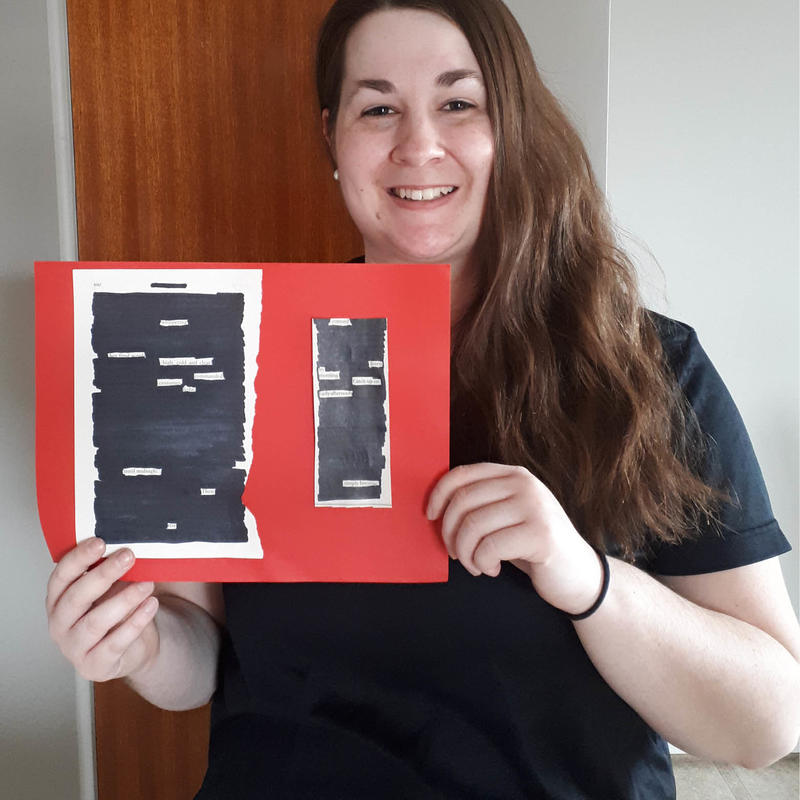It’s your friendly neighbourhood librarian here, Miranda. Like a lot of you, I am working from home and isolating to help stop the spread of COVID-19. However, April is International Poetry Month so I wanted to give you three poetry ideas to help spark your creativity. I’ve also provided alternatives to make these poems easier for you to do from home if you don’t have all the needed supplies.
You might be stuck inside, but your imagination is not. So, let’s make some poems.
Blackout Poetry
This is one of my personal favourites. All you need is a sharpie, an old book you don’t mind ruining the pages in or, alternatively, some newspaper.
Blackout Poetry is the art of “blacking out” all the words you don’t want on a page, while keeping the ones that will create the poem. There are two ways to do this, the first is to just go ahead and start blacking out words with no real planning. The second is a little more thought out.

Instructions
- Select a page from your book or an article from a newspaper.
- Rip out the page from the book or cut out the article from the newspaper.
- Scan the page first before reading it completely. Keep an eye out for an anchor word as you scan. An anchor word is one word on the page that stands out to you because it is packed and loaded with meaning and significance. Starting with an anchor word is important because it helps you to imagine possible themes and topics for your poem.
- Now read the page. Use a pencil to lightly circle any words that connect to the anchor word. Avoid circling more than three words in a row.
- List all of the circled words on a piece of paper. List the words in the order that they appear on the page of text from top to bottom, left to right.
- Select words, without changing their order on the list, and piece them together to create a poem.
- Return to the page of text and black out any of the words you haven’t chosen with sharpie. If you are feeling extra creative, you can blackout all the words you haven’t chosen with an illustration or design.
Concrete Poetry

This is the poem that requires the least amount of supplies. If you have paper and something to write with you are good to go. In my opinion it is also the most beautiful.
- Draw a shape in pencil. In the example below I did an umbrella.
- Along the drawing write words that are either associated with the item or be extra creative and write a poem along the lines. Optional: Fill in the entire space you drew with words instead of just following along with the lines you drew.
- Erase the pencil marks
Book Spine Poetry

This is probably the trickiest of the three poems to do. Book spine poetry is exactly as it sounds, you use the spines of books to create a poem. You do this by stacking the books on top of each other so they can be read.
A lot of you might not have access to a variety of books to do book spine poetry, the alternative is to draw or download a picture of stacked books and then write the titles of the books into the spines as I’ve done in the picture below. Don’t forget the author’s name.

Steps:
- If you have a lot of books select a few titles that have similar themes or just sound good to you. Jot them down on a piece of paper. You might notice some of them go together.
- Select the titles that could create a poem and either pull the books from the shelf, or alternatively, start writing them into your stacked book photo.
- If you are pulling books, once you have them, stack them in the order you want and take a picture! There you go!
- If there is a missing “line” in your book, you can search online for a book that would fill that space.
Remember, we aren’t looking for perfection! We’re looking to have fun!
If this has inspired you to read some poems, here's a list of Poetry Books available at MHPL.
With that, happy creating everyone! Please share your creations on social media and tag us @MHPublicLibrary.

 Posted on 06 April 2020 by Miranda.
Posted on 06 April 2020 by Miranda.